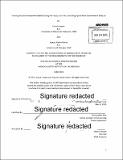| dc.contributor.advisor | Christopher Noe. | en_US |
| dc.contributor.author | Hoyme, David | en_US |
| dc.contributor.author | Farias-Eisner, Joseph | en_US |
| dc.contributor.other | Sloan School of Management. | en_US |
| dc.date.accessioned | 2015-09-29T19:00:06Z | |
| dc.date.available | 2015-09-29T19:00:06Z | |
| dc.date.copyright | 2015 | en_US |
| dc.date.issued | 2015 | en_US |
| dc.identifier.uri | http://hdl.handle.net/1721.1/99047 | |
| dc.description | Thesis: M.B.A., Massachusetts Institute of Technology, Sloan School of Management, 2015. | en_US |
| dc.description | Cataloged from PDF version of thesis. | en_US |
| dc.description | Includes bibliographical references. | en_US |
| dc.description.abstract | The principal topic of this paper addresses optimal turnaround strategies that businesses employ to reengineer value during times of financial distress. The scope of the paper focuses on investment banks during the financial crisis, which, according to the National Bureau of Economic Research, began in December 2007 and ended in June 2009. During that time, the world's financial system faltered and many banks and lending agencies across the globe faced turmoil. Governments were forced to step in to mitigate the disaster and to ensure that the largest businesses across industries did not cause a total collapse of the world economy. Amongst the largest investment banks some failed or were acquired and some survived the crisis. In this paper, we set out to answer the question: what turnaround strategies did investment banks employ to survive the financial crisis apart from taking government bailout money and restructuring legally? To answer this question we performed three levels of analysis: 1) researched the most effective turnaround 'levers' found through empirical academic studies; 2) researched accepted best practices from turnaround management firms; 3) interviewed numerous investment bankers, academics, and other financial industry professionals about their experiences during the crisis. Research and interviews revealed that one bank in particular, Goldman Sachs, took three steps that align with 'levers' found to be statistically significant in turning around financially distressed firms. It, 1) identified the root cause of the problem before taking a course of action; 2) took a growth oriented, strategic view and invested significant resources and time to ensure long term success; 3) communicated to clients and employees effectively and frequently about the short-term realities and its long-term commitments. We conclude that, while there are effective steps any business manager can take to turnaround a firm from financial distress, there is no set formula. The levers themselves are conceptually simple but difficult to execute in stressful and uncertain circumstances. Successful turnarounds arise when organizations execute prudent plans efficiently. Execution is efficient when organizations are able to unveil a problem at its core, adapt with the right sustainable solution, and unify individuals within an organization over a short time frame. | en_US |
| dc.description.statementofresponsibility | by David Hoyme and Joseph Farias-Eisner. | en_US |
| dc.format.extent | 38 pages | en_US |
| dc.language.iso | eng | en_US |
| dc.publisher | Massachusetts Institute of Technology | en_US |
| dc.rights | M.I.T. theses are protected by copyright. They may be viewed from this source for any purpose, but reproduction or distribution in any format is prohibited without written permission. See provided URL for inquiries about permission. | en_US |
| dc.rights.uri | http://dspace.mit.edu/handle/1721.1/7582 | en_US |
| dc.subject | Sloan School of Management. | en_US |
| dc.title | Turning around investment banks during the financial crisis : surviving apart from government bailouts | en_US |
| dc.type | Thesis | en_US |
| dc.description.degree | M.B.A. | en_US |
| dc.contributor.department | Sloan School of Management | |
| dc.identifier.oclc | 921502160 | en_US |
